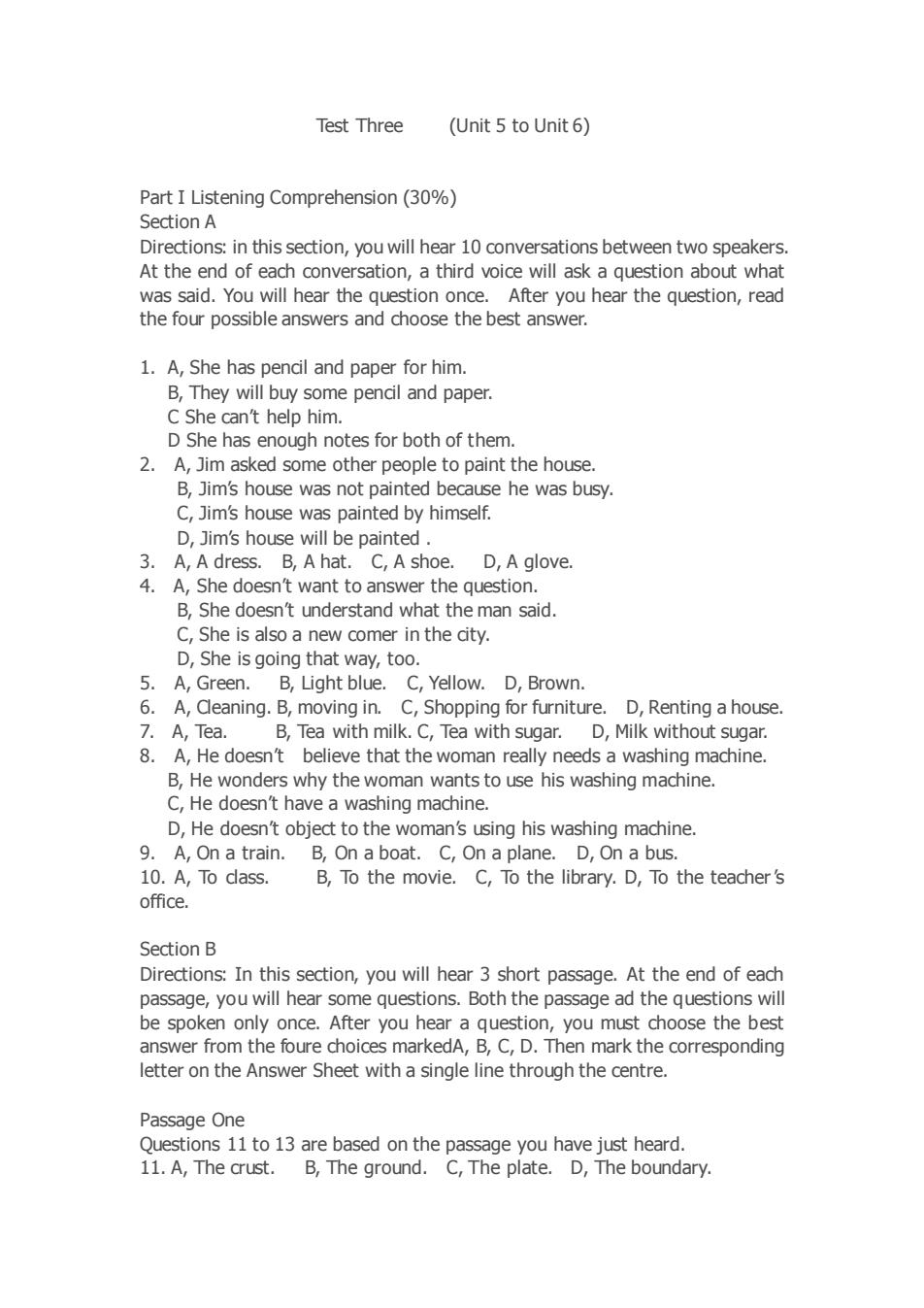
Test Three (Unit 5 to Unit 6) Part I Listening Comprehension(30%) Section A Diredtions:in this section.you will hear 10 conversations between two speakers At the end of each conve ,a third voic e will ask a question about what was said.You will hear the question once. After you hear the question,read the four possible answers and choose the best answer. 1.A,She has pencil and paper for him. B,They will buy some pencil and paper C.She ca an't help him. D She has enough notes for both of them. 2.A,Jim asked some other people to paint the house. B,Jim's house was not painted because he was busy. C.Jim's house was painted by himself. D.Jin n's h house will he A,A dress.B,A hat C,A shoe D,A glove. 4.A,She doesn't want to answer the question. B,She doesn't understand what the man said. C,She is also a new comer in the city. D,She is going that way,too. 5. A,G een Light blue ,Yellow.D,Brown. 6.A,Cleaning.B,moving in.C,Shopping for furniture.D,Renting a house 7.A,Tea. B,Tea with milk.C,Tea with sugar.D,Milk without sugar. 8.A,He doesn't believe that the woman really needs a washing machine. B,He wonders why the woman wants to use his washing machine. C He do 午ha ve a washing machine D,He doesn't object to the woman's using his washing machine. 9.A,On a train.B,On a boat.C,On a plane.D,On a bus. 10.A,To class. B,To the movie.C,To the library.D,To the teacher's office. Section B Directions:In this section,you will hear 3 short passage.At the end of each passage,you will hear some questions.Both the passage ad the questions will be spoken only once.After you hear a question,you must choose the best answer from the foure choices markedA,B.C,D.Then mark the corresponding letter on the Answer Sheet with a single line through the centre Passage One Questions 11 to 13 are based on the passage you have just heard. 11.A,The crust.B,The ground.C,The plate.D,The boundary
Test Three (Unit 5 to Unit 6) Part I Listening Comprehension (30%) Section A Directions: in this section, you will hear 10 conversations between two speakers. At the end of each conversation, a third voice will ask a question about what was said. You will hear the question once. After you hear the question, read the four possible answers and choose the best answer. 1. A, She has pencil and paper for him. B, They will buy some pencil and paper. C She can’t help him. D She has enough notes for both of them. 2. A, Jim asked some other people to paint the house. B, Jim’s house was not painted because he was busy. C, Jim’s house was painted by himself. D, Jim’s house will be painted . 3. A, A dress. B, A hat. C, A shoe. D, A glove. 4. A, She doesn’t want to answer the question. B, She doesn’t understand what the man said. C, She is also a new comer in the city. D, She is going that way, too. 5. A, Green. B, Light blue. C, Yellow. D, Brown. 6. A, Cleaning. B, moving in. C, Shopping for furniture. D, Renting a house. 7. A, Tea. B, Tea with milk. C, Tea with sugar. D, Milk without sugar. 8. A, He doesn’t believe that the woman really needs a washing machine. B, He wonders why the woman wants to use his washing machine. C, He doesn’t have a washing machine. D, He doesn’t object to the woman’s using his washing machine. 9. A, On a train. B, On a boat. C, On a plane. D, On a bus. 10. A, To class. B, To the movie. C, To the library. D, To the teacher’s office. Section B Directions: In this section, you will hear 3 short passage. At the end of each passage, you will hear some questions. Both the passage ad the questions will be spoken only once. After you hear a question, you must choose the best answer from the foure choices markedA, B, C, D. Then mark the corresponding letter on the Answer Sheet with a single line through the centre. Passage One Questions 11 to 13 are based on the passage you have just heard. 11. A, The crust. B, The ground. C, The plate. D, The boundary
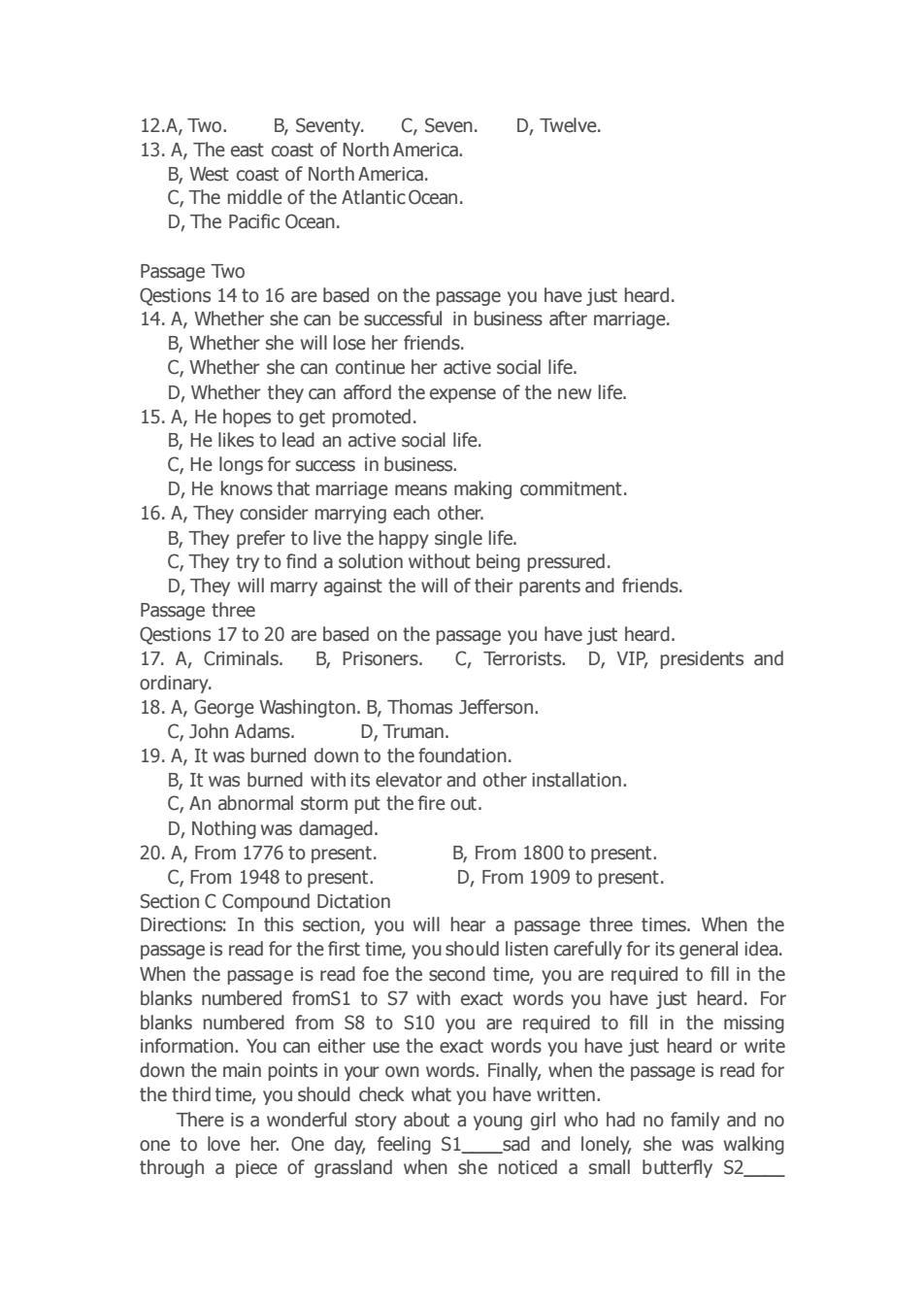
12.A,Two. B.Seventy. C.Seven. D.Twelve 13.A,The east coast of North America B,West st of North America C,The middle of the AtlanticOcean. D.The Pacific Ocean. Passage Two based on the passage you have just heard 4.A.Whether she can be successful in business after marriag B,Whether she will lose her friends. C.whether she can continue her active sodal life D,Whether they can afford the expense of the new life 15.A.He ho promoted C,He longs for success in business. D,He knows that marriage means making commitment. 16.A,They consider marrying each other. B,They prefer to live the happy single life They try to find a solutio ng pressured D,They will marry against the will of their parents and friends. Passage three Qestions 17 to 20 are based on the passage you have just heard. 17.A,Criminals. B,Prisoners. C,Terrorists.D,VIP,presidents and AGeorge Washington.B,Thomas Jefferson. C.John Adams. D,Truman. 19.A,It was burned down to the foundation. nebohehetoodohenaion D,Nothing was damaged 20.A,From 1776 to present. B,From 1800 to present. C.From 1948 to present. D,From 1909 to present. Section C Compound Dictation Directions:In this section,you will hear a passage three times.When the pa sage is read for the first you should listen carefully for its gene When the passage is read foe the second time,you are required to fill in the blanks numbered froms1 to S7 with exact words you have just heard.For blanks numbered from S8 to S10 you are required to fill in the missing information.You can either use the exact words you have just heard or write down the main points in yo own words.Finally,w he n the passage e is read for the third time,you should check what you have written There is a wonderful story about a young girl who had no family and no one to love her.One day,feeling S1_ sad and lonely,she was walking through a piece of grassland when she noticed a small butterfly S2
12.A, Two. B, Seventy. C, Seven. D, Twelve. 13. A, The east coast of North America. B, West coast of North America. C, The middle of the Atlantic Ocean. D, The Pacific Ocean. Passage Two Qestions 14 to 16 are based on the passage you have just heard. 14. A, Whether she can be successful in business after marriage. B, Whether she will lose her friends. C, Whether she can continue her active social life. D, Whether they can afford the expense of the new life. 15. A, He hopes to get promoted. B, He likes to lead an active social life. C, He longs for success in business. D, He knows that marriage means making commitment. 16. A, They consider marrying each other. B, They prefer to live the happy single life. C, They try to find a solution without being pressured. D, They will marry against the will of their parents and friends. Passage three Qestions 17 to 20 are based on the passage you have just heard. 17. A, Criminals. B, Prisoners. C, Terrorists. D, VIP, presidents and ordinary. 18. A, George Washington. B, Thomas Jefferson. C, John Adams. D, Truman. 19. A, It was burned down to the foundation. B, It was burned with its elevator and other installation. C, An abnormal storm put the fire out. D, Nothing was damaged. 20. A, From 1776 to present. B, From 1800 to present. C, From 1948 to present. D, From 1909 to present. Section C Compound Dictation Directions: In this section, you will hear a passage three times. When the passage is read for the first time, you should listen carefully for its general idea. When the passage is read foe the second time, you are required to fill in the blanks numbered fromS1 to S7 with exact words you have just heard. For blanks numbered from S8 to S10 you are required to fill in the missing information. You can either use the exact words you have just heard or write down the main points in your own words. Finally, when the passage is read for the third time, you should check what you have written. There is a wonderful story about a young girl who had no family and no one to love her. One day, feeling S1____sad and lonely, she was walking through a piece of grassland when she noticed a small butterfly S2____
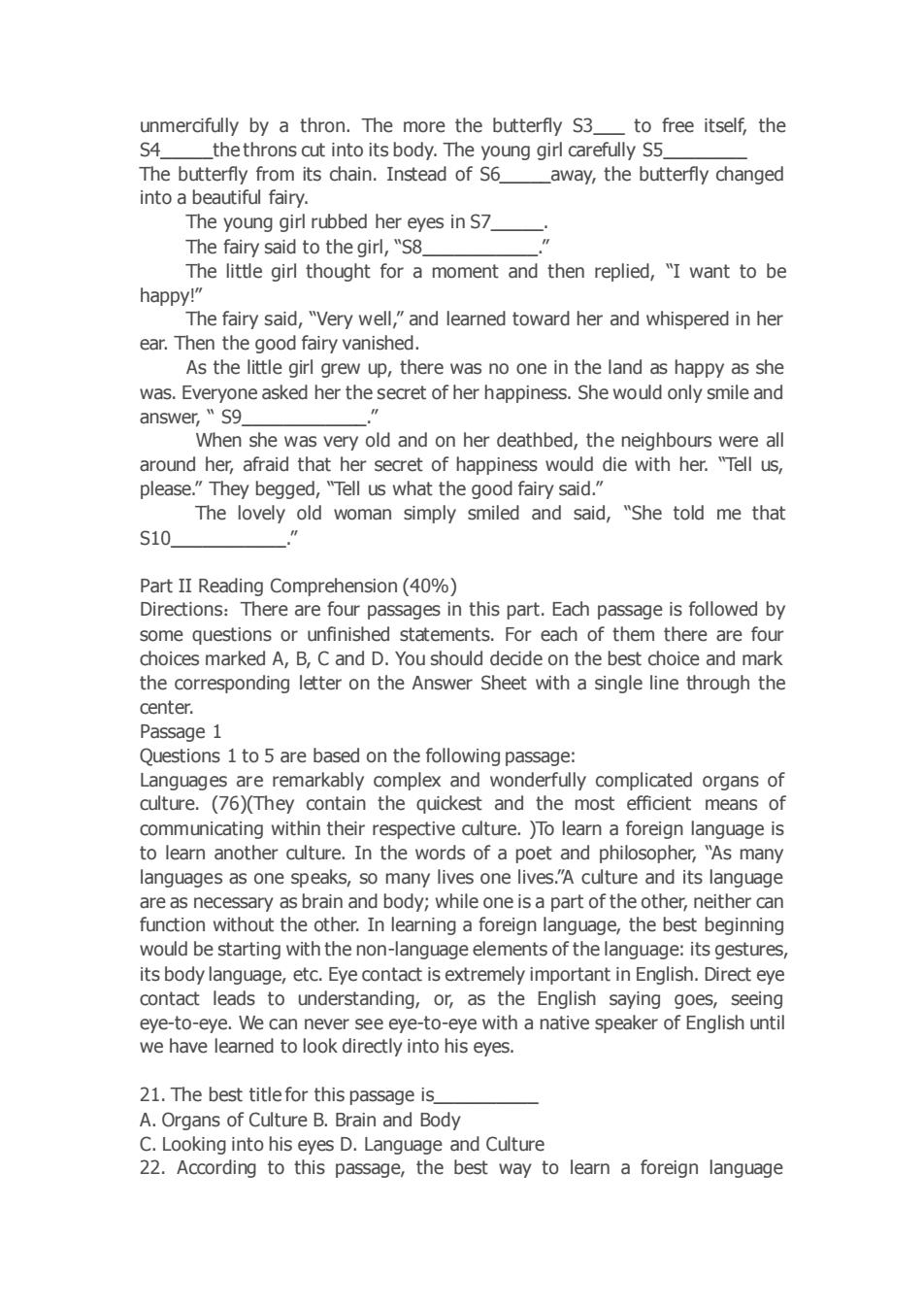
unmercifully by a thron.The more the butterfly S3_to free itself,the theth nto its body.The young girl carefully s5 The butterfly from its chain.Instead of S6 _away,the butterfly changed into a beautiful fairy. The young girl rubbed her eyes in S7_ The fairy said to the girl,"S8 The little girl thought for a moment and then replied,"I want to be happy The fairy said,"Very well,"and learned toward her and whispered in her ear.Then the good fairy vanished. As the little girl grew up,there was no one in the land as happy as she was.Everyone asked her the secret of her happiness.She would only smile and answer When she was very old and on her deathbed,the neighbours were all around her,afraid that her secret of happiness would die with her."Tell us, please."They begged,"Tell us what the good fairy said." The lovely old woman simply smiled and said,"She told me that S10 Part II Reading Comprehension(40%) Directions:There are four passages in this part.Each passage is followed by some questions or unfinished statements.For each of them there are four choices marked A,B,C and D.You should decide on the best choice and mark the corresponding letter on the Answer Sheet with a single line through the center. Passage 1 Questions 1 to 5 are based on the following passage: Languages are remarkably complex and w culture (76)(The contain the quicke efficient means of communicating within their respective culture.)To learn a foreign language is to learn another culture.In the words of a poet and philosopher,"As many languages as one speaks,so many lives one lives."A culture and its language are as necessary as brain and body:while one is a part of the other.neither can function without the other. In le ning a fo guage, the best beginning would be starting with the non-language elements of the language:its gestures, its body lanquage,etc.Eye contact is extremely important in English.Direct eye contact leads to understanding,or,as the English saying goes,seeing eye-to-eye.We can never see eye-to-eye with a native speaker of English until we have learned to look directly into his eyes. 21.The best title for this passage is. A.Organs of Culture B.Brain and Body C.Looking into his eyes D.Language and Culture 22.According to this passage,the best way to learn a foreign language
unmercifully by a thron. The more the butterfly S3___ to free itself, the S4_____the throns cut into its body. The young girl carefully S5________ The butterfly from its chain. Instead of S6_____away, the butterfly changed into a beautiful fairy. The young girl rubbed her eyes in S7_____. The fairy said to the girl, “S8___________.” The little girl thought for a moment and then replied, “I want to be happy!” The fairy said, “Very well,” and learned toward her and whispered in her ear. Then the good fairy vanished. As the little girl grew up, there was no one in the land as happy as she was. Everyone asked her the secret of her happiness. She would only smile and answer, “ S9____________.” When she was very old and on her deathbed, the neighbours were all around her, afraid that her secret of happiness would die with her. “Tell us, please.” They begged, “Tell us what the good fairy said.” The lovely old woman simply smiled and said, “She told me that S10___________.” Part II Reading Comprehension (40%) Directions:There are four passages in this part. Each passage is followed by some questions or unfinished statements. For each of them there are four choices marked A, B, C and D. You should decide on the best choice and mark the corresponding letter on the Answer Sheet with a single line through the center. Passage 1 Questions 1 to 5 are based on the following passage: Languages are remarkably complex and wonderfully complicated organs of culture. (76)(They contain the quickest and the most efficient means of communicating within their respective culture. )To learn a foreign language is to learn another culture. In the words of a poet and philosopher, “As many languages as one speaks, so many lives one lives.”A culture and its language are as necessary as brain and body; while one is a part of the other, neither can function without the other. In learning a foreign language, the best beginning would be starting with the non-language elements of the language: its gestures, its body language, etc. Eye contact is extremely important in English. Direct eye contact leads to understanding, or, as the English saying goes, seeing eye-to-eye. We can never see eye-to-eye with a native speaker of English until we have learned to look directly into his eyes. 21. The best title for this passage is__________ A. Organs of Culture B. Brain and Body C. Looking into his eyes D. Language and Culture 22. According to this passage, the best way to learn a foreign language
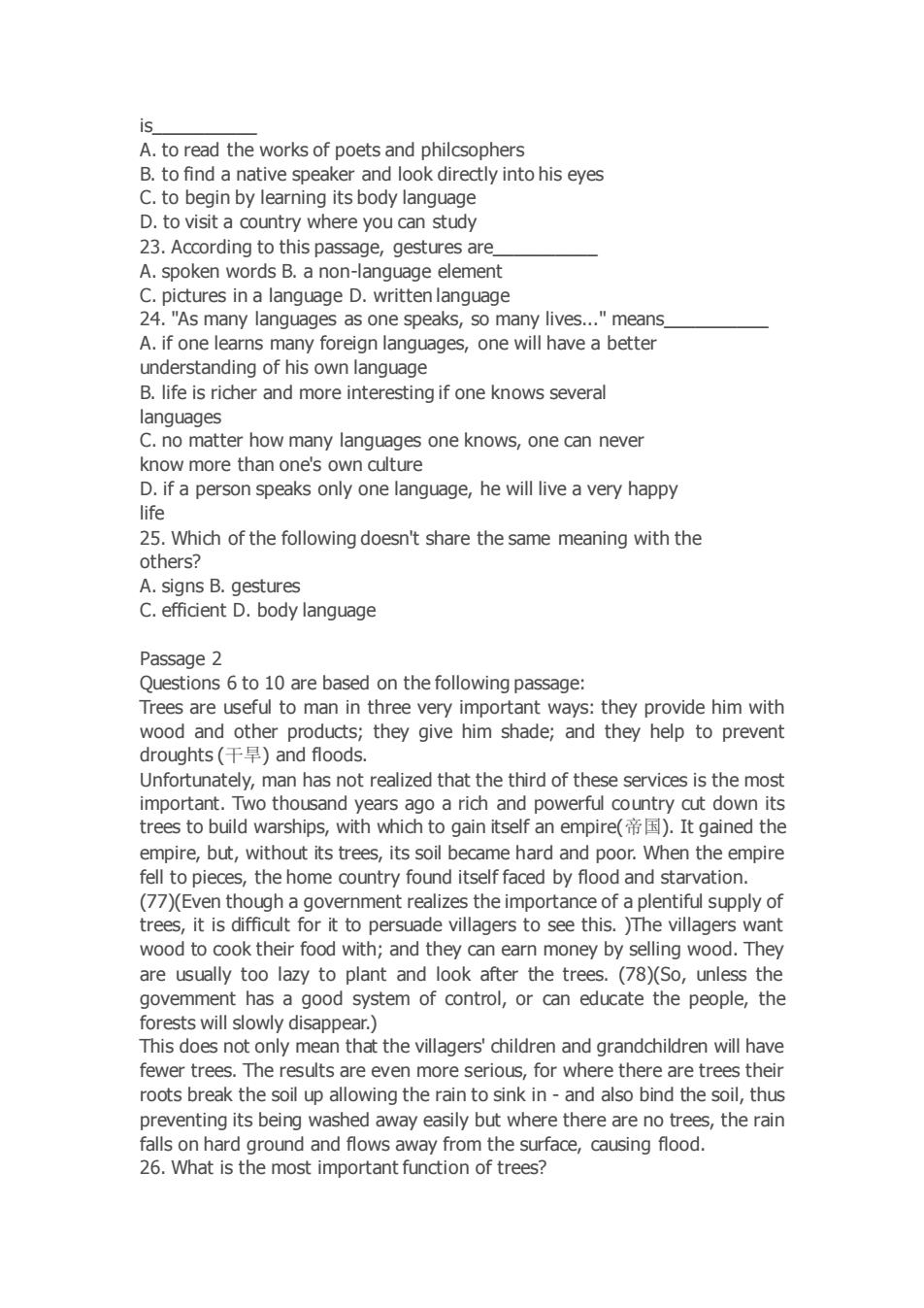
is A.to read the works of poets and philcsophers B.to ind da native spea er and look directly into his eyes C.to begin by learning its body language D.to visit a country where you can study 23.According to this passage.gestures are A.spoken words B.a non-language element ctures ina language D. A.if one learns many foreign languages,one will have a better understanding of his own language B.life is richer and more interesting if one knows several matter how many langus one ko ne v know more than one's own culture D.if a person speaks only one language,he will live a very happy life 25.Which of the following doesn't share the same meaning with the others? A.signs B.gestures C.efficient D.body language Passage 2 based n thefolowing passage: Trees are useful to man in three very important ways:they provide him with wood and other products;they give him shade;and they help to prevent droughts千早)and floods. Unfortunately.man has not realized that the third of these services is the most warships,with whic ago a rich and powerfu country cu dow & gain itsel an empire(帝目 empire,but,without its trees,its soil became hard and poor.When the empire fell to pieces,the home country found itself faced by flood and starvation. (77)(Even though a government realizes the importance of a plentiful supply of trees,it is difficult for it to persuade villagers to see this.)The villagers want wood to their food with;and they car earn money by sel ing wo d.They are usually too lazy to plant and look after the trees.(78)(So,unless the govemment has a good system of control,or can educate the people,the forests will slowly disappear.) This does not only mean that the villagers'children and grandchildren will have fewer trees.The results are ever more serious,for v here e there are trees their preventing its being washed away easily but where there are no trees,the rain falls on hard ground and flows away from the surface,causing flood. 26.What is the most important function of trees?
is__________ A. to read the works of poets and philcsophers B. to find a native speaker and look directly into his eyes C. to begin by learning its body language D. to visit a country where you can study 23. According to this passage, gestures are__________ A. spoken words B. a non-language element C. pictures in a language D. written language 24. "As many languages as one speaks, so many lives..." means__________ A. if one learns many foreign languages, one will have a better understanding of his own language B. life is richer and more interesting if one knows several languages C. no matter how many languages one knows, one can never know more than one's own culture D. if a person speaks only one language, he will live a very happy life 25. Which of the following doesn't share the same meaning with the others? A. signs B. gestures C. efficient D. body language Passage 2 Questions 6 to 10 are based on the following passage: Trees are useful to man in three very important ways: they provide him with wood and other products; they give him shade; and they help to prevent droughts (干旱) and floods. Unfortunately, man has not realized that the third of these services is the most important. Two thousand years ago a rich and powerful country cut down its trees to build warships, with which to gain itself an empire(帝国). It gained the empire, but, without its trees, its soil became hard and poor. When the empire fell to pieces, the home country found itself faced by flood and starvation. (77)(Even though a government realizes the importance of a plentiful supply of trees, it is difficult for it to persuade villagers to see this. )The villagers want wood to cook their food with; and they can earn money by selling wood. They are usually too lazy to plant and look after the trees. (78)(So, unless the govemment has a good system of control, or can educate the people, the forests will slowly disappear.) This does not only mean that the villagers' children and grandchildren will have fewer trees. The results are even more serious, for where there are trees their roots break the soil up allowing the rain to sink in - and also bind the soil, thus preventing its being washed away easily but where there are no trees, the rain falls on hard ground and flows away from the surface, causing flood. 26. What is the most important function of trees?
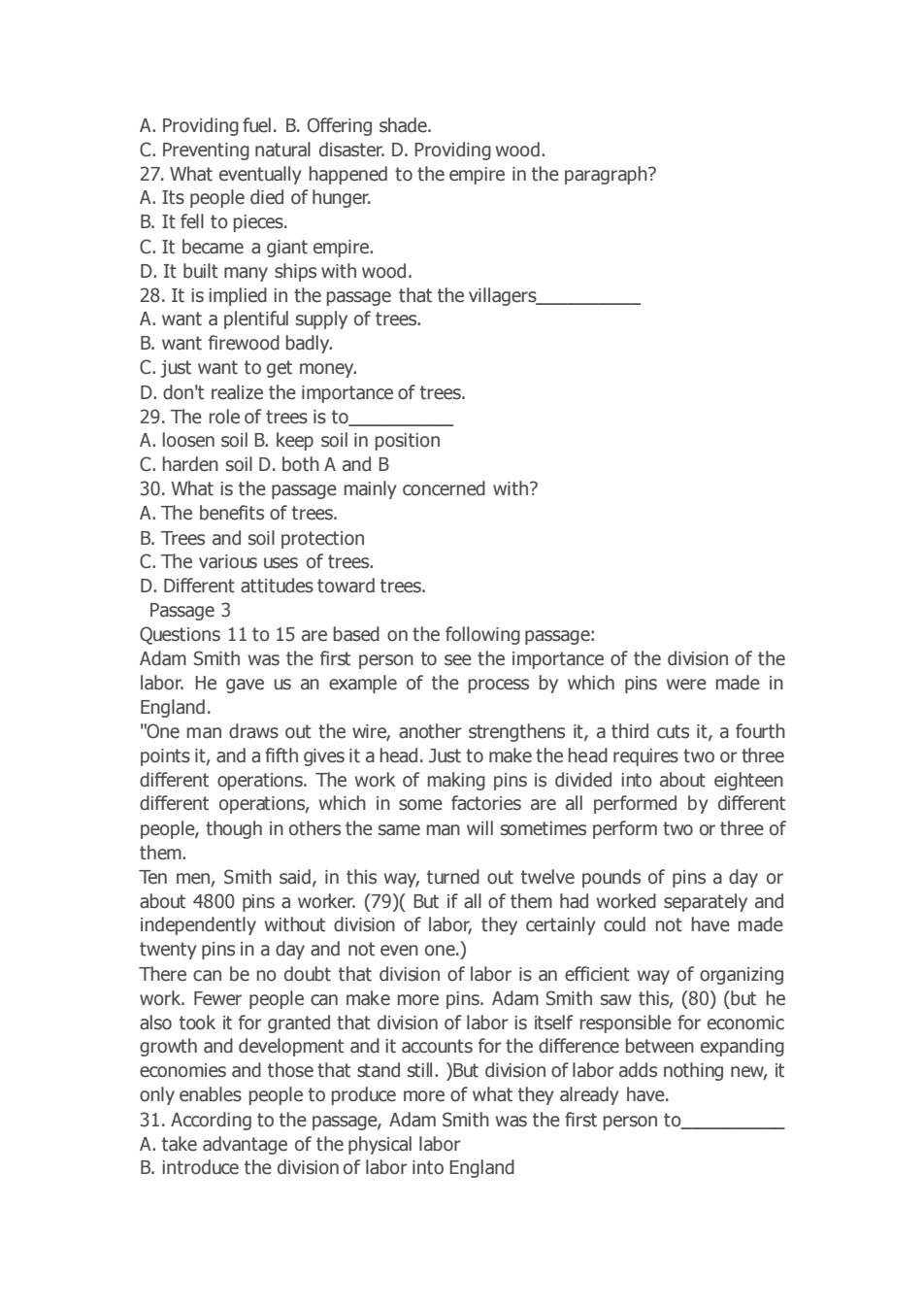
A.Providing fuel.B.Offering shade. C Pr r.D.Providing wood. 27.What eventually happened to the empire in the paragraph? A.Its people died of hunger. B.It fell to pieces. C.It became a giant empire D It built an ships with wood 28.It isimplied n the passage that the villagers A.want a plentiful supply of trees. B.want firewood badly. C.just want to get money. D.don't realize the importance of trees 29.The role trees is to A.loosen soil B.keep soil in position C.harden soil D.both A and B 30.What is the passage mainly concerned with? A.The benefits of trees ection D.Different attitudes toward trees. Passade 3 Questions 11 to 15 are based on the following passage Adam Smith was the first person to see the importance of the division of the labor. e gave us an example of the process by which pins were made in England. "One man draws out the wire,another strengthens it,a third cuts it,a fourth points it,and a fifth gives it a head.Just to make the head requires two or three different operations.The work of making pins is divided into about eighteen differe nt operations,which in some e fac s are all performed by differer people,though in others the same man will sometimes perform two or three of them. Ten men,Smith said,in this way,turned out twelve pounds of pins a day or about 4800 pins a worker.(79)(But if all of them had worked separately and without division of labor,they certainly could not have made twenty pins in a d ay and d not e ven one. There can be no doubt that division of labor is an efficient way of organizing work.Fewer people can make more pins.Adam Smith saw this,(80)(but he also took it for aranted that division of labor is itself responsible for economic growth and deve elopment and it accounts for the differe and those that stand still.)But divi on of nce between expanding dds nothing new,it only enables people to produce more of what they already have. 31.According to the passage,Adam Smith was the first person to_ A.take advantage of the physical labor B.introduce the division of labor into England
A. Providing fuel. B. Offering shade. C. Preventing natural disaster. D. Providing wood. 27. What eventually happened to the empire in the paragraph? A. Its people died of hunger. B. It fell to pieces. C. It became a giant empire. D. It built many ships with wood. 28. It is implied in the passage that the villagers__________ A. want a plentiful supply of trees. B. want firewood badly. C. just want to get money. D. don't realize the importance of trees. 29. The role of trees is to__________ A. loosen soil B. keep soil in position C. harden soil D. both A and B 30. What is the passage mainly concerned with? A. The benefits of trees. B. Trees and soil protection C. The various uses of trees. D. Different attitudes toward trees. Passage 3 Questions 11 to 15 are based on the following passage: Adam Smith was the first person to see the importance of the division of the labor. He gave us an example of the process by which pins were made in England. "One man draws out the wire, another strengthens it, a third cuts it, a fourth points it, and a fifth gives it a head. Just to make the head requires two or three different operations. The work of making pins is divided into about eighteen different operations, which in some factories are all performed by different people, though in others the same man will sometimes perform two or three of them. Ten men, Smith said, in this way, turned out twelve pounds of pins a day or about 4800 pins a worker. (79)( But if all of them had worked separately and independently without division of labor, they certainly could not have made twenty pins in a day and not even one.) There can be no doubt that division of labor is an efficient way of organizing work. Fewer people can make more pins. Adam Smith saw this, (80) (but he also took it for granted that division of labor is itself responsible for economic growth and development and it accounts for the difference between expanding economies and those that stand still. )But division of labor adds nothing new, it only enables people to produce more of what they already have. 31. According to the passage, Adam Smith was the first person to__________ A. take advantage of the physical labor B. introduce the division of labor into England